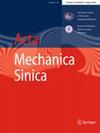Meso-indentation-based nonlinear mechanical characterization of human meniscus in patients with knee osteoarthritis
Abstract
The meniscus plays an important role in the biomechanical function of the knee joint, but knee osteoarthritis (OA) deteriorates the mechanical properties of the meniscus. Thus understanding the mechanical behaviour of the OA meniscus is very important. This study aimed to assess the quasi-static nonlinear mechanical behaviours of the three zones of the OA meniscus by a proposed meso-indentation method, and further to investigate its nonlinear mechanical responses under the stance. Four pairs of menisci were harvested from OA patients during total knee arthroplasty. One pair of the menisci was first used for the histological analysis. Binocular fringe projection technology was then employed to reconstruct the morphology of the other three pairs of the menisci. Subsequently, a meso-indentation method was proposed to characterize the nonlinear behaviors of the meniscus zones, moreover, the hyperelastic model (HEM) together with the Hertz’s elastic model (EM) was used to fit the indentation force-depth curves of the meniscus zones. Furthermore, the fitted HEM and EM materials parameters were used to simulate the mechanical response of the meniscus in the stance by two simplified meniscus models. The results showed that the type III collagen widely existed in the OA menisci, and the red-white zone exhibited the best mechanical performance, and the 3-term Mooney-Rivlin model was the best descriptor for the nonlinear mechanical characterization of the three zones. Moreover, the stress or strain distributions of the simplified meniscus models differed significantly between the HEM and EM under the stance, and the EM underestimated the mechanical behaviours of the meniscus. The current work generally provides a novel testing method to study the nonlinear mechanical behaviour of soft biological materials, and is specifically helpful to understand the nonlinear mechanical behaviour of the OA meniscus for which the HEM should be used in the meniscus-related biomechanical studies.

 求助内容:
求助内容: 应助结果提醒方式:
应助结果提醒方式:


